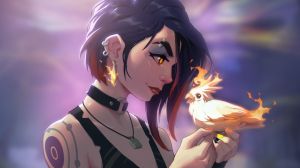
She Could Fly #1, the first of four issues from Dark Horses’ Berger Books imprint, is a deep title that tackles mental health issues head-on. From the minds of writer Christopher Cantwell (AMC’s Halt and Catch Fire), artist Martin Morazzo (Ice Cream Man), and colorist Miroslav Mrva, the book is a masterful tale of a world just finding out that there is a powered human among them.
Videos by ComicBook.com
Luna, the book’s main character, is somebody who’s obsessed with the flying lady who’s been seen on the news. As a matter of fact, the story opens up with her talking about her obsession with the superhuman to her school’s guidance counselor. You see, Luna suffers from obsessive-compulsive disorder, a mental illness that Cantwell himself has lived with for thirty-some years.
Throughout the issue, Luna suffers several episodes, for lack of a better term, in which she envisions gravely hurting herself or others in order to cope with her condition. The back-and-forth between reality and Luna’s visions creates a poignant view into what people that suffer from OCD go through on a daily basis.

On the surface, She Could Fly is a Moon Knight-like tale that sees the protagonist have to battle themselves over what’s real versus what’s fiction. As you digger deeper into the issue, however, you find a complex tale that provides many surprises. As Cantwell explains in this issue’s epilogue, comics have given him a “wonderful medium” to portray Primarily Obsessional OCD as what it really is — “vivid and disturbing mental thoughts that feel as real as anything.”
And damn, does Cantwell use that to paint a beautiful story. Although he provides a deep, rich supporting cast, there’s not a real villain, per se. Rather, Luna – or her thoughts, that is — serves as her own antagonist. Even though Luna remains stoic through much of issue, we see glimmers of character development throughout.
And about that supporting cast. You have Luna’s blue-collar working parents and Luna’s grandmother Kido, an apparent monk who’s just returned from a pilgrimage. Most interesting of the supporting roles, however, is the almost-too-stereotypical nerdy government scientist by the name of Bill Meigs. Meigs appears to be an operative working for the Chinese government, and he’s presumably had something to do with the flying lady and her subsequent death.
In addition to the primary story arc of Luna and her demons, Meigs’ espionage-like subplot provided enough of a backup story to break up the issue into easier to consume chunks so it didn’t get to dense throughout.

Morazzo’s art matches the story nearly perfectly. To me, the art reminded me most of the late great Steve Dillon. The line art nor the colors are flashy by any measure of the word, but the art doesn’t need to be flashy. It needs to portray a dark, gritty, almost grim-like tale, and it does that exactly. Think of some of Dillon’s work on the deepest, darkest Punisher runs. The art gets the job done, that’s for sure.
In the issue, Luna heads into the crime scene where the flying lady exploded — yes, exploded — and debates jumping off a bridge. As Luna battles her internal demons on the bridge, she eventually sits down, deciding to not end her life. In the most poignant panel in the entire issue, Luna reminds us that she “can still learn to fly” as she sits down, sparing her own life. By the time the issue wraps, this series can go anywhere; She Could Fly is a book that encourages you to dive into the themes and ideology behind what’s just on the page.
Published by Dark Horse Comics
On July 11, 2018
Written by Christopher Cantwell
Art by Martin Morazzo
Colors by Miroslav Mrva
Lettering by Clem Robins








